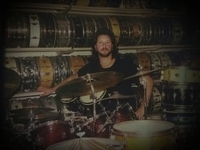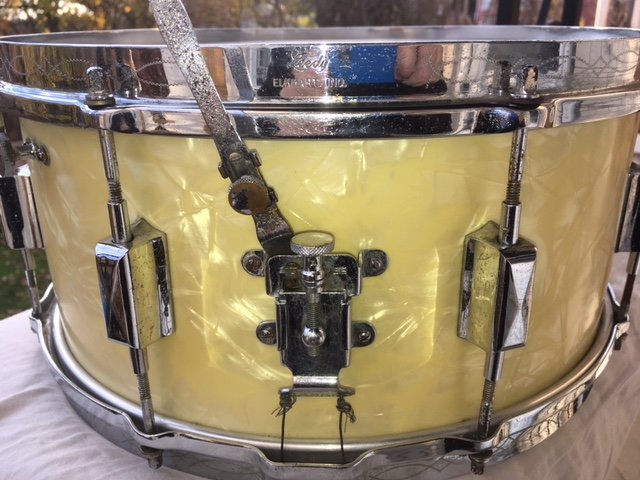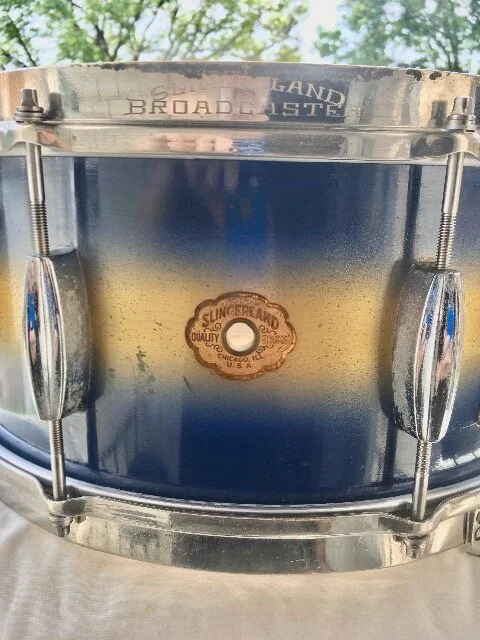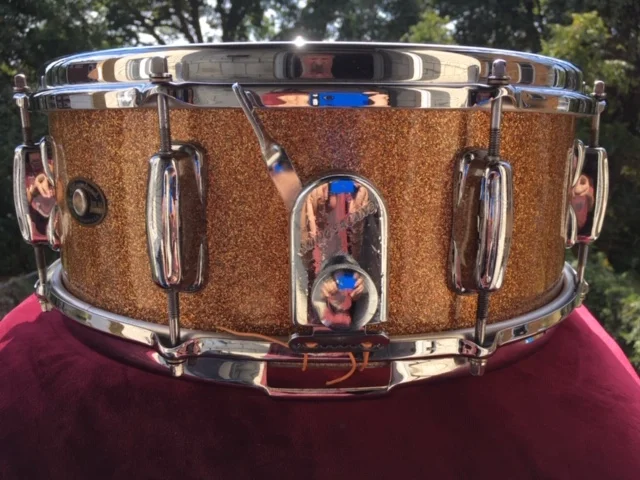James D. Anzelone is a vintage drum collector, technician, enthusiast and expert for over 35 years. Instructor of drumline, drum set and percussion for several Pennyslvania schools. He is a member of P.A.S., a recording artist and studio musician. James plays drum set for his band Threshold and is also a guest speaker on drum history and percussion for Carnegie Mellon University.
Here is a great example of a 1954 Leedy & Ludwig 6.5”x14” Dance Model snare drum in white marine pearl finish in outstanding condition without any blemishes.
This drum is a leftover 1930s Leedy 6.5”x14”, “Broadway Parallel”. The finish is blue and silver Duco, and is equipped with a solid, 1-ply maple shell.
In the 1930s, Gretsch was in the early stages of developing their metal brass shell snare. These models started off with a center beaded shell that was one piece, seamless in design and plated nickel over brass. The very first models came equipped with six tubular lugs, single flanged hoops and an outsourced strainers from a major drum competitor. It is important to note that catalogs referencing these early 30s model snare drums are very rare and hard to come by. Most
Here is a great example of a 1938 Leedy Broadway Standard in white marine pearl. Leedy only offered this unique 4-point strainer on these models for one year. This snare was special ordered with ornate engraved rims. All hardware was ordered and upgraded to the optional chrome plating. Chrome plating was more expensive than nickel for the upgrade.
Unfortunately, Gretsch had a drum model with a similar name. Their Broadcaster was spelled with a K instead of a C. When Gretsch realized the similarities, they felt it was an infringement on their own drum products and rights. A lawsuit ensued and the court ruled in favor of Gretsch, so Slingerland had to drop the Broadcaster name, so it was only produced from 1934 to 1935.
In 1978-79 Slingerland put together a new campaign to reissue the Radio King model. This time, the new Radio King was made exclusively as a limited edition snare drum model.
According to Slingerland’s catalogs, the “Ben Pollack “Radio King” model was only produced for two years, between 1936-1938. This is a significant reason why this model is extremely rare and desirable. Also, the drum consumers of the day were placing overwhelming orders to Slingerland for the Krupa model. All of this was certainly because of Gene Krupa’s major popularity and drumming success.
The finish was Abalone Pearl! And, the Drum that this beautiful finish is attached to is a 1930s Leedy 5x14 Broadway Standard Model. I have actually only seen this finish on a Slingerland 1930s Radio King snare drum and a miscellaneous vintage bass drum. What a beautiful, stunning and striking finish this is. The Abalone Pearl has a three dimensional vibe that really illuminates with the change of natural lighting. The array of beautiful colors is what makes this finish pop. Apparently, there are only a handful of drums with this rare finish that exist. Also, I have not seen another Leedy snare drum equipped with the Abalone Pearl finish.
In 1963 the Slingerland Drum Company introduced a new snare drum to their drum line. This snare was cataloged and advertised as the new Modern Artist model. Previously, Slingerland used the Artist model name on their earlier snare drum line from 1928 to approximately 1935. Some of these first models were hand engraved and very ornate. They were made with ten tube lugs and both solid wood and brass shells.
Here is a wonderful example of a very rare late 30s, Slingerland 5x14 Radio King metal shell snare drum. The shell is heavy brass, one piece, and nickel plated brass. According to Slingerland’s catalogs of this era, this metal shell snare could only be ordered in 5x14 or 6.5x14 sizes The plating options available were either nickel or chromium. Unlike the popular “Krupa" model, there was limited information describing all options that were available when ordering the metal version. Most likely, these metal shells were much like a special order that was requested and specified by the consumer.
Here is a wonderful example of a rare, black diamond pearl Rolling Bomber snare drum. This particular snare drum is unique in that most Rolling Bombers produced were ordered with the popular white marine pearl. Black diamond pearl was very uncommon for this time period.
During Slingerland’s pinnacle time of manufacturing a drummer could actually request a special color order that they envisioned. Some of these orders produced were for a "mono" or one solid color lacquered painted finish. These unique finishes were much more uncommon to find on Slingerland drums of this vintage era. Here are four examples of Slingerland Radio King snare drums produced with "Solid" lacquer colored finishes.
...a rare and unusual aspect of this drum is it was made with a solid one ply maple shell construction instead of the normal plywood shell.
In my early days of collecting, I often asked myself, “What is this model?” or “Why is this snare drum made like this and inconsistent with similar drums of this era?”, or “Why is this snare drum different than the one in the catalog?” As I grew more familiar with Slingerland drum catalogs and references, I became a vintage Slingerland drum detective of sorts. I learned to read between the lines of the typical and not so typical examples. I discovered that these hybrids came into existence because of the supply and demand issues at the factory.
In 1940 Slingerland decided to go back to the drawing board and create a new Radio King snare drum model. This model would become known as the “New Super Gene Krupa Model” with a unique and innovative strainer system which became known as the "clam shell" strainer. Unlike the Gene Krupa 6.5” x 14” model with the three point strainer and eight center streamline lugs, this new Radio King snare had been drastically redesigned.
















This snare drum is a rare 1950s Leedy & Ludwig White Marine Pearl 5” x14”, Broadway model with a solid 1-ply maple shell.